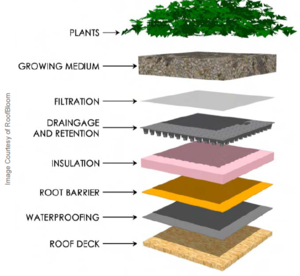
Difference between revisions of "MS4 fact sheet - Green Roofs"
(Created page with "==Green Roofs== ===The benefits of green roofs and examples of successful programs=== Green roofs are becoming commonly accepted and installed across the Upper Midwest on bu...") |
|||
| Line 4: | Line 4: | ||
Green roofs are becoming commonly accepted and installed across the Upper Midwest on buildings of all shapes and sizes. Green roofs are being utilized as a means to reduce costs associated with the life-cycle of conventional roofs, and heating and cooling. In addition, they are being used to address stormwater management and large green roofs are being used to create spaces for public benefit in urban settings. This fact sheet focuses on the benefits of green roofs and provides examples of municipal programs and resolutions for municipal buildings. | Green roofs are becoming commonly accepted and installed across the Upper Midwest on buildings of all shapes and sizes. Green roofs are being utilized as a means to reduce costs associated with the life-cycle of conventional roofs, and heating and cooling. In addition, they are being used to address stormwater management and large green roofs are being used to create spaces for public benefit in urban settings. This fact sheet focuses on the benefits of green roofs and provides examples of municipal programs and resolutions for municipal buildings. | ||
| + | |||
| + | [[File:Cross-section of a typical green roof.PNG|right|thumb|300 px|alt=This image shows cross-section of a typical green roof|<font size=3>Cross-section of a typical green roof</font size>]] | ||
===Benefits / Pollution Reduction=== | ===Benefits / Pollution Reduction=== | ||
Revision as of 20:18, 1 March 2017
Contents
Green Roofs
The benefits of green roofs and examples of successful programs
Green roofs are becoming commonly accepted and installed across the Upper Midwest on buildings of all shapes and sizes. Green roofs are being utilized as a means to reduce costs associated with the life-cycle of conventional roofs, and heating and cooling. In addition, they are being used to address stormwater management and large green roofs are being used to create spaces for public benefit in urban settings. This fact sheet focuses on the benefits of green roofs and provides examples of municipal programs and resolutions for municipal buildings.
Benefits / Pollution Reduction
Green roofs offer several benefits such as reduced runoff, increased evapo-transpiration, prolonged roof life, reduced roof temperature, decreased energy costs, reduction of the urban heat island, habitat for birds and insects, carbon sequestration, improved air quality, and enjoyment and increased productivity for adjacent building occupants. Green roofs also have aesthetic qualities which help to meet landscaping requirements, and they create additional living space if constructed properly. The possibilities of so many benefits, particularly in urban high-density environments such as downtown Minneapolis and St. Paul, have triggered the use of green roofs.
Program Development & Implementation
Types of Green Roofs
A green roof typically consists of the following components listed from the bottom upward: roof deck; a waterproof membrane to protect the building from leaks; a root barrier to prevent roots from penetrating the waterproof membrane; an insulation layer; a drainage layer, usually made of lightweight gravel or plastic; a geotextile or filter mat that allows water to soak through but prevents erosion of fine soil particles; a growing medium; plants; and, sometimes, an erosion control blanket.
There are two general types of green roofs: extensive and intensive. Structural load capacity, that is, how much weight the roof can hold, is a significant factor in determining whether an extensive or intensive green roof should be considered from a design and liability standpoint.
